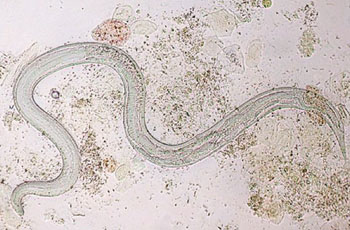Five Serologic Tests Evaluated for Threadworm Infection Follow-Up
By LabMedica International staff writers
Posted on 25 Feb 2015
Traditional fecal-based methods have poor sensitivity for the detection of Strongyloides stercoralis, therefore are inadequate for post-treatment evaluation of infected patients who should be carefully monitored to exclude the persistence of the infection.Posted on 25 Feb 2015
The performance of the five serological tests has been compared for the follow up of patients after treatment, who were infected with S. stercoralis or threadworm, in order to identify if antibody decline could be used a surrogate marker for cure, in addition to negative stools.

Image: Adult female of Strongyloides stercoralis collected in bronchial fluid of a patient with disseminated disease (Photo courtesy of Sacro Cuore Hospital).
Scientists at the Center for Tropical Diseases, Sacro Cuore Hospital (CTD; Verona, Italy) and an international team carried out retrospective study on archived, anonymized sera available at the CTD. Samples were classified according to a composite reference standard, a procedure used for evaluation of diagnostic tests when there is no gold standard: a) positive: positive fecal tests and/or at least 3/5 positive serologic tests; b) negative: negative fecal tests and less than three positive results out of the five serologic tests.
The samples were tested with two commercially-available enzyme-linked immunosorbent assays (ELISA) for Strongyloides (IVD Research; Carlsbad, CA, USA, and Bordier Affinity Products; Crissier, Switzerland), and three noncommercial tests: immunofluorescence antibody test (IFAT), recombinant Strongyloides antigen (NIE) enzyme-linked immunosorbent assay (NIE-ELISA), and the NIE- luciferase immunoprecipitation systems (NIE-LIPS).
A high proportion of samples demonstrated for each test a seroreversion or a relevant decline in optical density/relative light units halved or decreases of at least two titers for IFAT at follow up. The results confirmed by the linear mixed effects model that showed a trend to seroreversion over time for all tests. In particular, IVD-ELISA where almost 90% samples demonstrated relevant decline and almost 87% of IFAT had the best performances. Considering only samples with a complete negativization, NIE-ELISA showed the best performance with 72.5% seroreversion.
The authors that concluded that each of the serology tests considered can be used for monitoring patients who received a treatment for S. stercoralis infection. Serology, in combination with fecal-based methods, should be used as the preferred tool for the follow up. Validation of polymerase chain reaction (PCR) techniques for the follow up might be a useful support for situations of uncertainty such as patients with serology values that do not seem to decrease over time. The study was published on February 10, 2015, in the journal Public Library of Science Neglected Tropical Diseases.
Related Links:
Center for Tropical Diseases
IVD Research
Bordier Affinity Products







 Analyzer.jpg)






